
Catalog excerpts

Implants trauma Anterior Clavicle Locking Plates System
Open the catalog to page 1
CAUTION: Federal Law (USA) restricts this device to sale by or on the order of a board certified physician. WARNING: If there is no sufficient bone healing, wrong or incomplete postoperative care, plate might break. All ITS plates are preformed anatomically as a matter of principle. If adjustment of the plate to the shape of the bone is required, this is possible by carefully bending gently in one direction once. Particular care is required when bending in the region of a plate hole, as deformation of the plate may lead to a failure of the locking mechanism. The plate must not be buckled or...
Open the catalog to page 2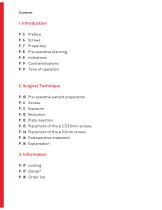
1. Introduction P. 5 Preface P. 6 Screws P. 7 Properties P. 8 Pre-operative planning P. 8 Indications P. 9 Contraindications P. 9 Time of operation 2. Surgical Technique P. 10 Pre-operative patient preparation P. 11 Access P. 11 Exposure P. 12 Reduction P. 12 Plate insertion P. 13 Placement of the 0 2.7/3.0mm screws P. 14 Placement of the 0 3.5mm screws P. 16 Postoperative treatment P. 16 Explantation 3. Information P. 17 Locking P. 17 Dotize® P. 18 Order list
Open the catalog to page 3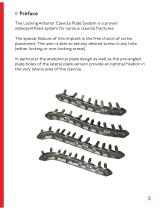
Preface The Locking Anterior Clavicle Plate System is a proven osteosynthesis system for various clavicle fractures. The special feature of this implant is the free choice of screw placement. The user is able to set any desired screw in any hole (either locking or non-locking screw). In particular the anatomical plate design as well as the pre-angled plate holes of the lateral plate version provide an optimal fixation in the very lateral area of the clavicle.
Open the catalog to page 5
Cortical Screw, Locking, D=3.5mm, SH Spiral Drill D=2.7mm, L=100mm, AO Connector Screwdriver, WS 2.5, self-holding sleeve Spiral Drill D=2.7mm, L=100mm, AO Connector Screwdriver, WS 2.5, self-holding sleeve Cortical Screw, D=2.7mm Spiral Drill D=2.0mm, L=100mm, AO Connector Screwdriver, Torque, T9x70 Cancellous Stabilization Screw, D=3.0mm, RH Spiral Drill D=2.0mm, L=100mm, AO Connector Screwdriver, Torque, T9x70
Open the catalog to page 6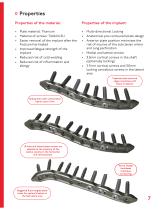
Properties Properties of the material: • Plate material: Titanium • Material of screws: TiAl6V4 ELI • Easier removal of the implant after the fracture has healed • Improved fatigue strength of the implant • Reduced risk of cold welding • Reduced risk of inflammation and allergy • Multi-directional Locking • Anatomical pre-contoured plate design • Anterior plate position minimizes the risk of injuries of the subclavian artery and lung perforation • Medial and lateral version • 3.5mm cortical screws in the shaft (optionally locking) • 2.7mm cortical screws and 3.0mm locking cancellous screws...
Open the catalog to page 7
Pre-operative planning Meta- and diaphyseal clavicle fractures Far lateral clavicle fractures Open and closed fractures Non-unions Mal-unions Corrective os
Open the catalog to page 8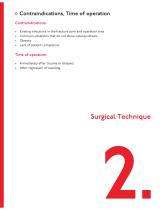
Contraindications: ♦ Existing infections in the fracture zone and operation area ♦ Common situations that do not allow osteosynthesis ♦ Obesity ♦ Lack of patient compliance Time of operation: ♦ Immediately after trauma or delayed ♦ After regression of swelling
Open the catalog to page 9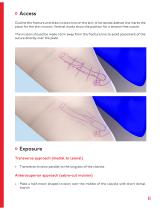
Access Outline the fracture and draw incision line on the skin. A horizontal dashed line marks the place for the skin incision. Vertical marks show the position for a tension free suture. The incision should be made 1-2cm away from the fracture line to avoid placement of the suture directly over the plate. Exposure Transverse approach (medial to lateral) • Transverse incision parallel to the long axis of the clavicle. Anterosuperior approach (sabre-cut incision) • Make a half-moon shaped incision over the middle of the clavicle with short dorsal branch
Open the catalog to page 11
Reduction • Temporary fixation of the fracture parts using forceps • Seek compression of the fracture • Control under fluoroscopy Plate insertion Insert the plate from lateral to medial under a bone holding forceps and additionally fix in place with two clamps. Optionally, the plate can be stabilized using the ITS. Temporary Plate Holder (58164-150). Confirmation of correct plate position under fluoroscopy.
Open the catalog to page 12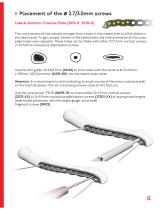
Placement of the Ø 2.7/3.0mm screws Lateral Anterior Clavicle Plate (21119-X; 21120-X) The cross section of the clavicle changes from a tube in the medial area to a flat ellipse in the lateral area. To gain proper fixation in the lateral area, the hole dimension of the outer plate holes were adjusted. These holes can be filled with either D=2.7mm cortical screws or D=3.0mm cancellous stabilization screws. Use the drill guide, D=2.0/2.7mm (62202) to bore holes with the spiral drill D=2.0mm, L=100mm, AO Connector (61203-100) into the lateral plate holes. Attention: It is recommend to drill...
Open the catalog to page 13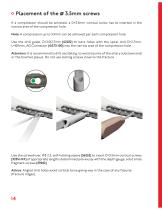
Placement of the Ø 3.5mm screws If a compression should be achieved, a D=3.5mm cortical screw has to inserted in the narrow area of the compression hole. Note: A compression up to 3.5mm can be achieved per each compression hole. Use the drill guide, D=2.0/2.7mm (62202) to bore holes with the spiral drill D=2.7mm, L=100mm, AO Connector (61273-100) into the narrow area of the compression hole. Attention: It is recommend to drill oscillating, to avoid injuries of the artery subclavia and/ or the brachial plexus. Do not use locking screws close to the fracture. Use the screwdriver, WS 2.5,...
Open the catalog to page 14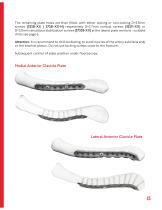
The remaining plate holes are then filled, with either locking or non-locking D=3.5mm screws (32351-XX / 37351-XX-N) respectively D=2.7mm cortical screws (32271-XX) or D=3.0mm cancellous stabilization screws (37303-XX) at the lateral plate versions - suitable drills see page 6. Attention: It is recommend to drill oscillating, to avoid injuries of the artery subclavia and/ or the brachial plexus. Do not use locking screws close to the fracture. Subsequent control of plate position under fluoroscopy. Medial Anterior Clavicle Plate Lateral Anterior Clavicle Plate
Open the catalog to page 15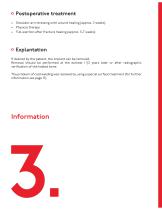
Postoperative treatment • Shoulder-arm dressing until wound healing (approx. 2 weeks) • Physical therapy • Full exertion after fracture healing (approx. 5-7 weeks) Explantation If desired by the patient, the implant can be removed. Removal should be performed at the earliest 1 1/2 years later or after radiographic verification of the healed bone. The problem of cold welding was resolved by using a special surface treatment (for further information see page 17).
Open the catalog to page 16All I.T.S. catalogs and technical brochures
-
ufs
1 Pages
-
DHL
2 Pages
-
ITS
2 Pages
-
PHL
24 Pages
-
CFN
32 Pages
-
OLS
24 Pages
-
PHLs
20 Pages
-
CTN - Cannulated Tibia Nail
28 Pages
-
SR Sacral Rods
20 Pages
-
HCS
24 Pages
-
TOS Twist-Off Screw
20 Pages
-
TLS
20 Pages
-
PRS-RX
32 Pages
-
HLS
20 Pages
-
ES
20 Pages
-
SR
20 Pages
-
FL
24 Pages
-
PL - Pilon Locking Plate small
12 Pages
-
OL - Olecranon Locking Plate
24 Pages
-
CAS
40 Pages
-
FCN
20 Pages
-
HOL
24 Pages
-
FLS
24 Pages
-
PFL
20 Pages
-
DTL
24 Pages
-
HTO
24 Pages
-
PTL
32 Pages
-
DFL
32 Pages
-
SCL
32 Pages
-
SLS
24 Pages
-
CAL
20 Pages
-
DUL
24 Pages
-
CLS
28 Pages



























































